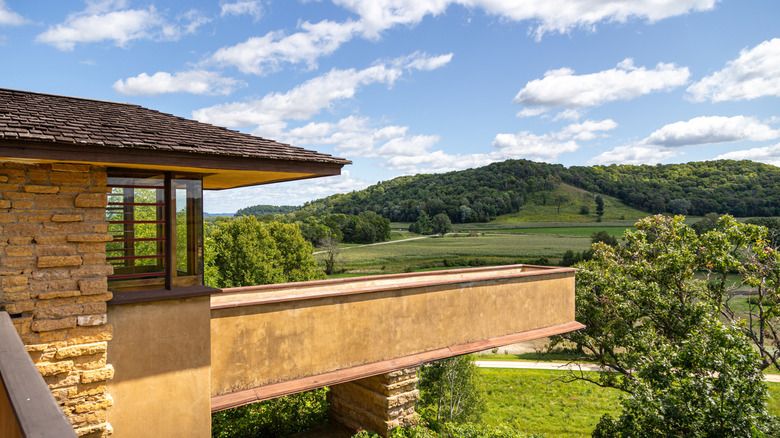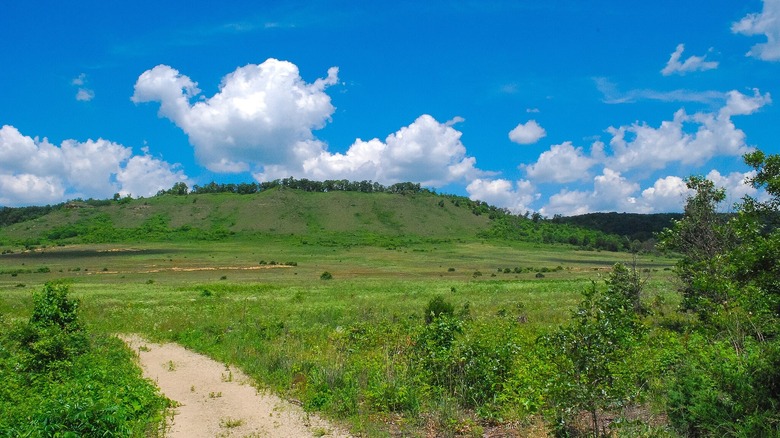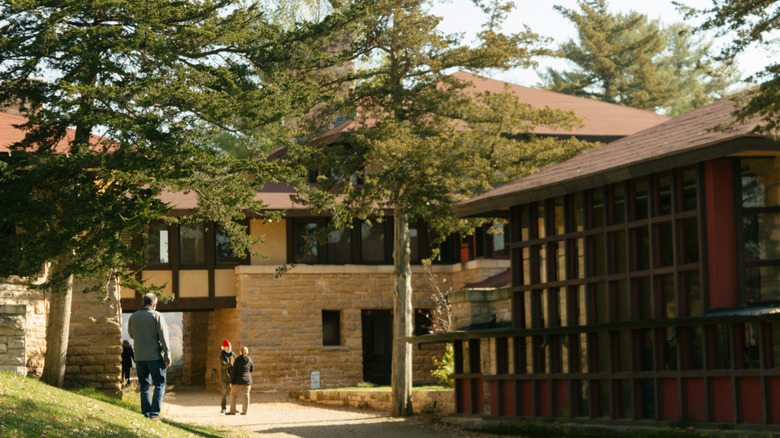Escape Madison At A Nearby Secret Town Known As The 'Wisconsin Desert' Full Of Unique Attractions
Madison and Milwaukee steal much of the spotlight when it comes to visitors exploring Wisconsin. Seeing as these cities are home to some of America's best breweries and the largest producer-only farmer's market in the country, that's not all that shocking. But just beyond those urban centers lies a rich array of smaller cities and towns that make Wisconsin the compelling, sometimes dichotomous, three-dimensional destination that it is. Spring Green, a small town located 40 miles west of Madison, embodies this spirit. With a population of approximately 1,519 people, this town offers a tranquil escape from the city. But that serene backdrop belies a potent cultural identity and distinct geography that you might not expect to find in such a place.
The surprises start with the Spring Green Preserve, a striking 1,100-acre expanse of sandy prairies known as "the Wisconsin Desert," a seeming oxymoron if there ever was one. A gem of a local ecosystem, this unique landscape comprises sandy dunes and bluffs instead of the dense forests the state is known for, while making this an excellent backdrop for hiking, birdwatching, and letting the countryside breeze brush off whatever worries you may be carrying.
The town's cultural significance is just as captivating. Frank Lloyd Wright, the famous designer whose work helped define America's architectural identity, built his Midwestern estate in Spring Green, and the complex remains one of the country's most treasured landmarks. Other cultural touchstones like the American Players Theatre, the second-largest outdoor theater dedicated to putting on classic plays in the country, help give Spring Green its happily peculiar reputation. Combined with local shops, taverns, and a thriving culinary scene, Spring Green provides a well-balanced mix of the relaxed and the intriguing for any visitor.
Spring Green's unique desert landscape
In a state known for its flat farmland and deciduous forests, the Spring Green Preserve is a must-see for visitors to the area. The desert-like geography is wholly distinct for a Midwestern landscape; sand prairies, black oak barrens (a kind of savanna dominated by oak trees), and even prickly pear cacti make up the vistas here, creating a rare ecosystem reminiscent of the American West. Such prairie used to be more widespread in Wisconsin, but centuries of development have resulted in its near-complete erasure, making the Spring Green Preserve all the more valuable and unequaled.
A 1.6-mile hiking trail extends through the preserve's Eastern portion, moving visitors along easy-going prairie and then up a rather steep, rocky bluff that demands a more-than-modest climbing effort. The reward, however, is a gorgeous view from the top of the bluff overlooking green fields, woodland, and valleys in the distance. Throughout the hike, keep an eye out for Blazing Star and Venus Looking Glass plant species, Western Meadowlark birds, and Tiger Beetles.
If you're looking for a more relaxed way to see the town and its surroundings, check out the Spring Green Cactus Cruise, a biking route that passes right by the preserve. Spring Green sits right on the Wisconsin River, and visitors who want to see more of the outdoors after exploring its sandy interior should head to Tower Hill State Park, just a stone's throw across the river. The park features hiking trails, a canoe landing on the river, and a restored tower from the 1800s that used to produce lead ammunition.
A cultural juggernaut in Spring Green
Spring Green's cultural identity and reputation far exceed its humble size, as the town is deeply intertwined with the legacy of the architect Frank Lloyd Wright. Taliesin — Wright's 800-acre estate just across the Wisconsin River — remains one of America's most significant architectural landmarks. It features many of Wright's design hallmarks, like open floor plans and hanging eaves, and he chose to use local materials like limestone and sand from the Wisconsin River while constructing the home, which blends into the landscape in a way that expands upon Wright's Prairie Style, the now iconic calling card of American residential architecture in the 20th century. The privately owned estate offers several tour options, ranging from the 4-hour Estate Tour to the far more succinct Highlights Tour.
Nearby sits the House on the Rock, a structure built on top of an outcropping of rock that contains a bizarre array of collections assembled by its builder, Alex Jordan. Opened to the public in 1960, the House on the Rock features the world's largest (and arguably most outlandish) carousel at 80-feet in length. Other standouts include a 200-foot-long sea monster and a 218-foot-long Infinity Room, 140 feet of which reach unsupported over the valley floor below thanks to a 105-yard concrete counterweight.
When you've finished taking in the House on the Rock's oddities, consider catching a play at the American Players Theatre, a picturesque woodland performance center just a 5-minute drive outside Spring Green. Renowned for its stellar reproductions of Shakespearean dramas, the professional theater features two stages, including a newly renovated outdoor amphitheater that seats over 1,000 and the more intimate Touchstone Theatre. Plays run from June to November annually. For more gems in the area, check out the underrated Wisconsin city with scenic lakefront quirks.


